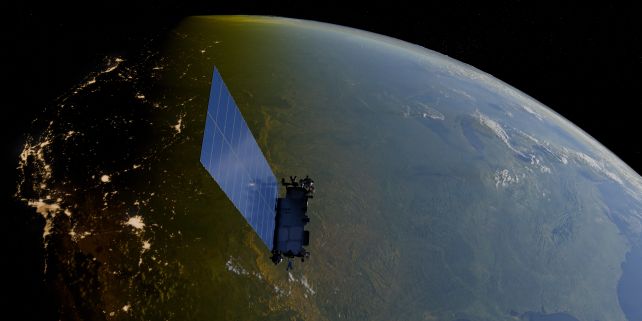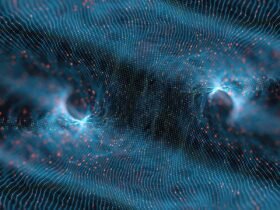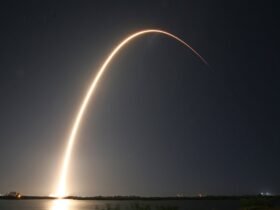The Sun is the angriest it’s been in a while – and it’s taking out that rage on the thousands of tiny satellites that make up SpaceX’s Starlink fleet.
A new analysis of Starlink satellites falling from the sky has revealed a distinct pattern: as the Sun escalated towards the peak of its activity cycle between 2020 and 2024, so too did the number of satellite falls as a direct result of that activity.
A team of scientists, led by space physicist Denny Oliveira of the NASA Goddard Space Flight Center, studied 523 Starlink satellites that fell back down towards Earth during that time, and found a clear link with the Sun.
“We clearly show that the intense solar activity of the current solar cycle has already had significant impacts on Starlink reentries,” they write in their paper.
“This is a very exciting time in satellite orbital drag research, since the number of satellites in low-Earth orbit and solar activity are the highest ever observed in human history.”

The solar cycle is an 11-year cycle of fluctuations in the Sun’s activity that centers around a periodic magnetic reversal of the solar poles. It primarily manifests as sunspots, solar flares, and coronal mass ejections that steadily increase towards solar maximum (when the poles flip), and then wanes to a minimum before inching back up again.
It’s just the Sun’s normal way to be, and we’re currently at the peak of the 25th cycle since we started keeping track of them. It’s actually been a pretty strong cycle; not the strongest on record, but still displaying much more solar activity than scientists predicted at its beginning.
This means that its effects on Earth have been pretty strong. You may have noticed a lot of aurora activity; that’s the effect of solar particles pummeling Earth’s atmosphere, borne by coronal mass ejections and the solar wind.
But the increase in solar activity has another, less noticeable effect: the increase in solar ejections buffeting the upper atmosphere heats it up significantly.
 frameborder=”0″ allow=”accelerometer; autoplay; clipboard-write; encrypted-media; gyroscope; picture-in-picture; web-share” referrerpolicy=”strict-origin-when-cross-origin” allowfullscreen>
frameborder=”0″ allow=”accelerometer; autoplay; clipboard-write; encrypted-media; gyroscope; picture-in-picture; web-share” referrerpolicy=”strict-origin-when-cross-origin” allowfullscreen>We don’t notice it here on the surface. But the increased energy puffs up the atmosphere – enough to increase the amount of drag on spacecraft in low-Earth orbit. This means they cannot hold course at their current trajectory, and need to make adjustments to remain in the sky.
To be clear, all satellites in low-Earth orbit are vulnerable to the increase in drag associated with solar activity. To date, however, SpaceX has launched 8,873 Starlink satellites into low-Earth orbit, of which 7,669 remain operational. These sheer numbers provide an excellent laboratory for studying the effect of solar maximum on satellites in low-Earth orbit.
“Here, we use … Starlink orbital data to perform a superposed epoch analysis of orbital altitudes and velocities in order to identify impacts caused by storms with different intensities,” the researchers write. “The Starlink reentries coincide with the rising phase of solar cycle 25, a period with increasing solar activity.”
SpaceX first started launching Starlink satellites in 2019, and the first atmospheric reentries began in 2020. Initially these figures stayed relatively low. There were just two in 2020. In 2021, 78 satellites fell; 99 in 2022, and 88 in 2023. But then 2024 saw a whopping increase – a total of 316 Starlink satellites fell out of the sky.
 frameborder=”0″ allow=”accelerometer; autoplay; clipboard-write; encrypted-media; gyroscope; picture-in-picture; web-share” referrerpolicy=”strict-origin-when-cross-origin” allowfullscreen>
frameborder=”0″ allow=”accelerometer; autoplay; clipboard-write; encrypted-media; gyroscope; picture-in-picture; web-share” referrerpolicy=”strict-origin-when-cross-origin” allowfullscreen>The researchers grouped these reentries according to the geomagnetic conditions at the time – that is, how powerfully solar activity was affecting Earth. Oddly, some 72 percent of all reentries occurred during weak geomagnetic conditions, not the powerful geomagnetic storms.
This, the researchers found, was because of the cumulative effect of drag over the rising period of the solar cycle. Rather than being taken down in one fell swoop, the orbits of these satellites degraded subtly over time. Meanwhile, the satellites that did fall during strong geomagnetic conditions fell faster than those that fell in weaker conditions.
It’s fascinating stuff, actually. We don’t have a lot of data on this phenomenon; the work of Oliveira and his colleagues may help design strategies to mitigate the orbital decay induced by solar activity, keeping satellites in low-Earth orbit where they should be (and not, for example, smacking into other satellites and triggering a nasty Kessler cascade).
“Our results are promising because they point in the direction of using short-cadence Starlink data (precise orbit determination, neutral mass density, ram direction area, drag coefficient) for the improvement of orbital drag models during geomagnetic storms, particularly during extreme events,” the researchers write.
The paper has been accepted for publication in Frontiers in Astronomy and Space Science, and is available on arXiv.













Leave a Reply